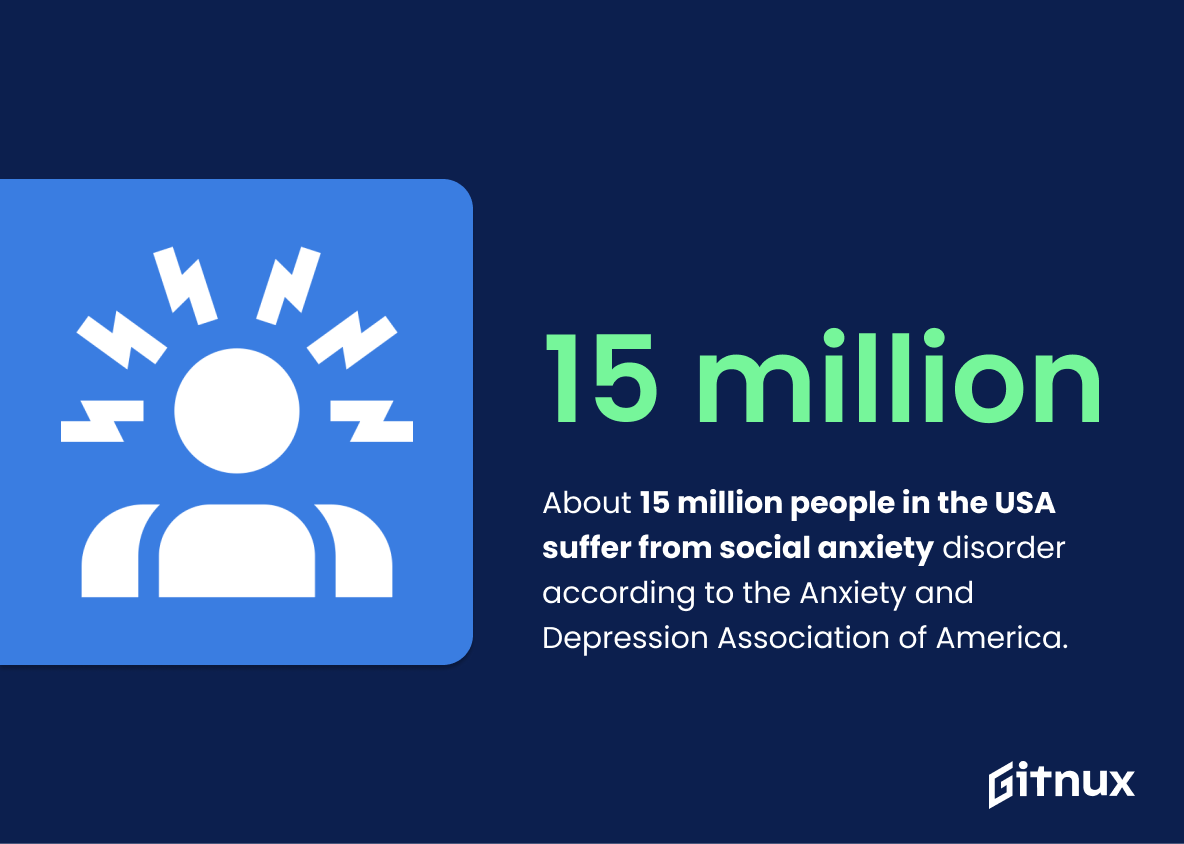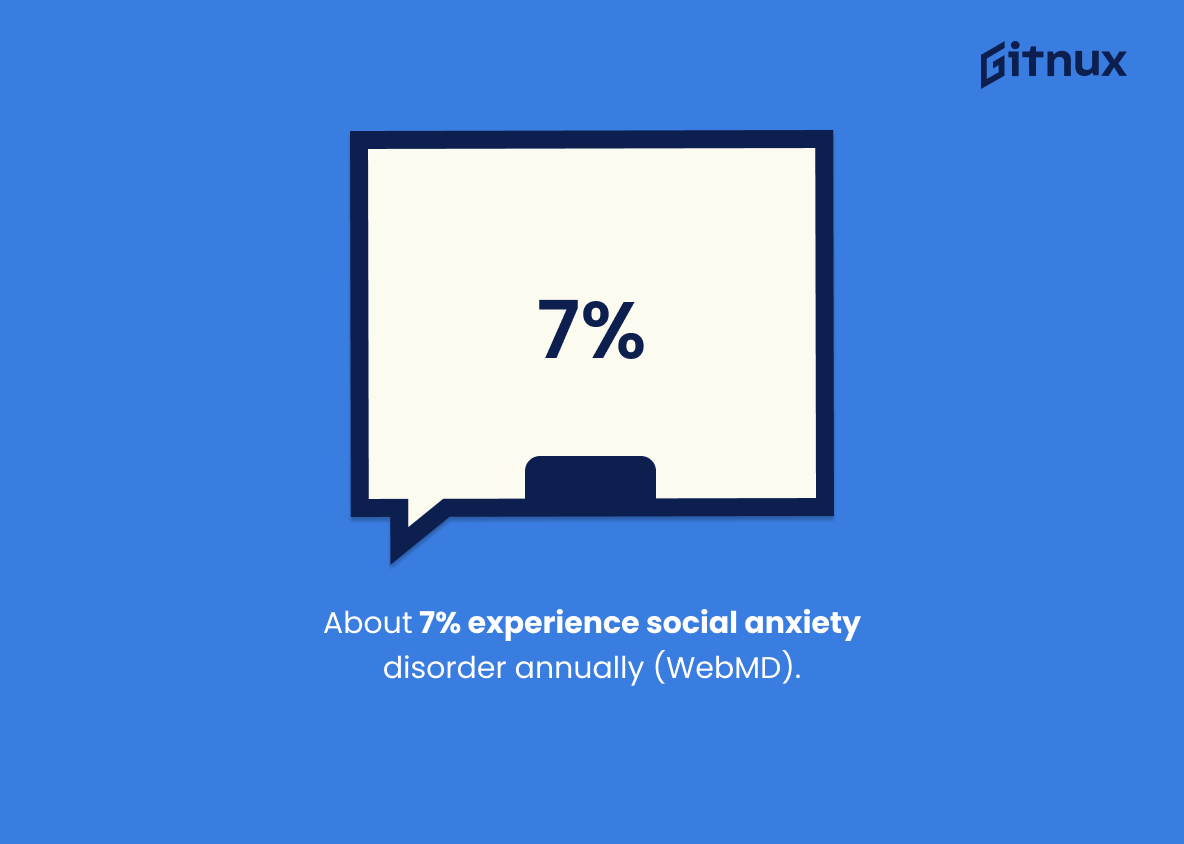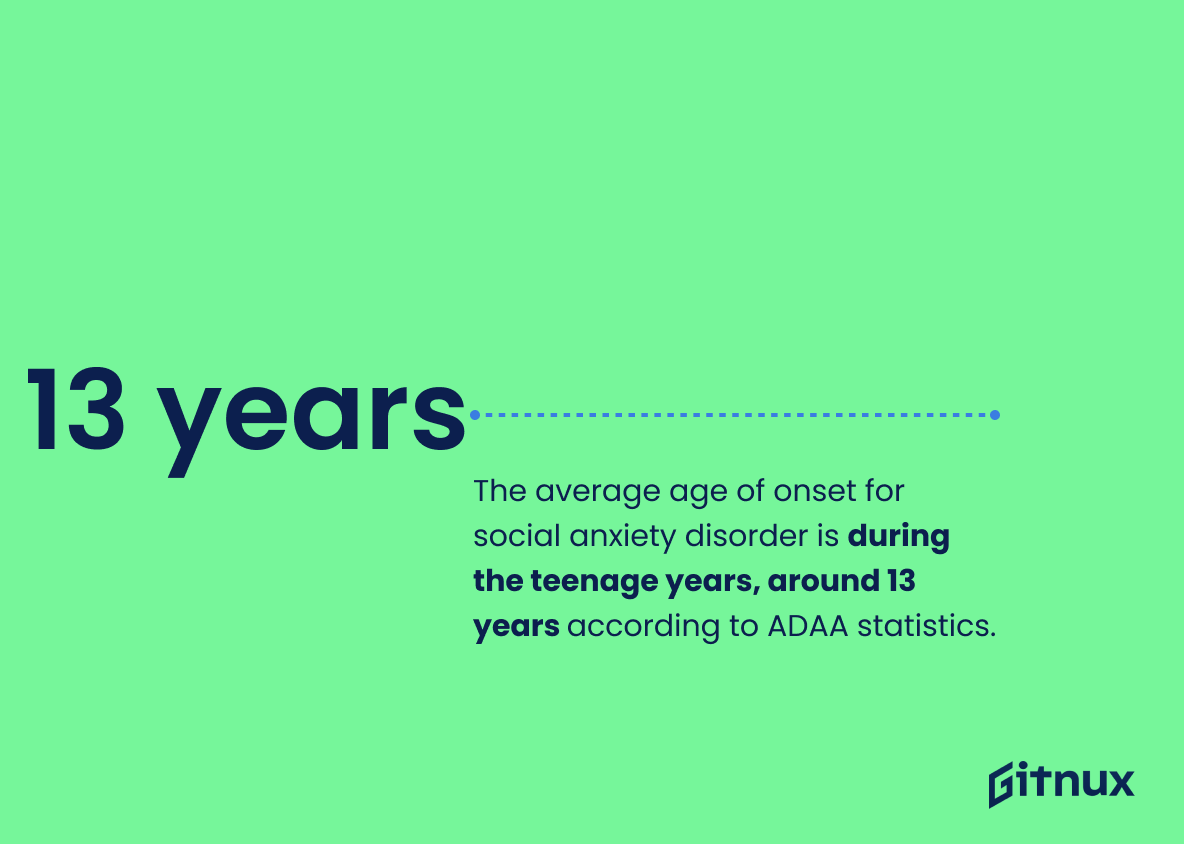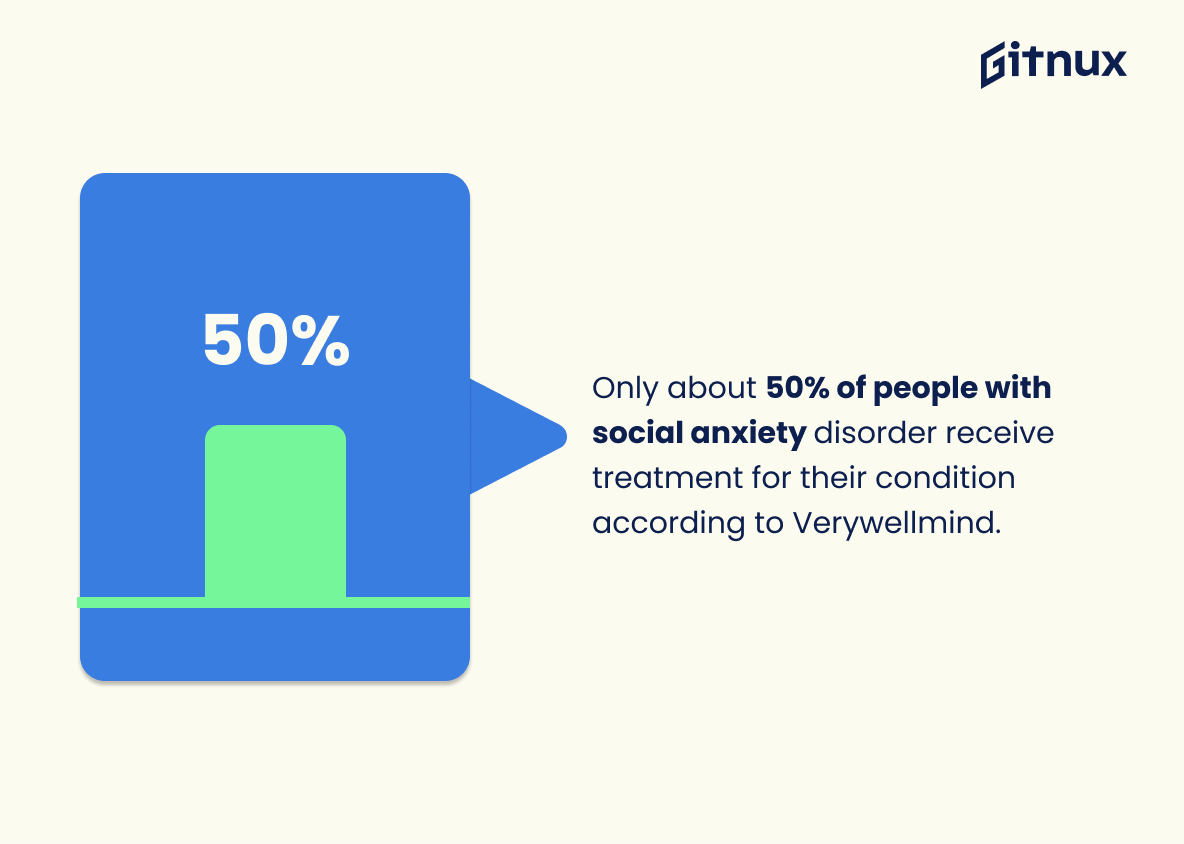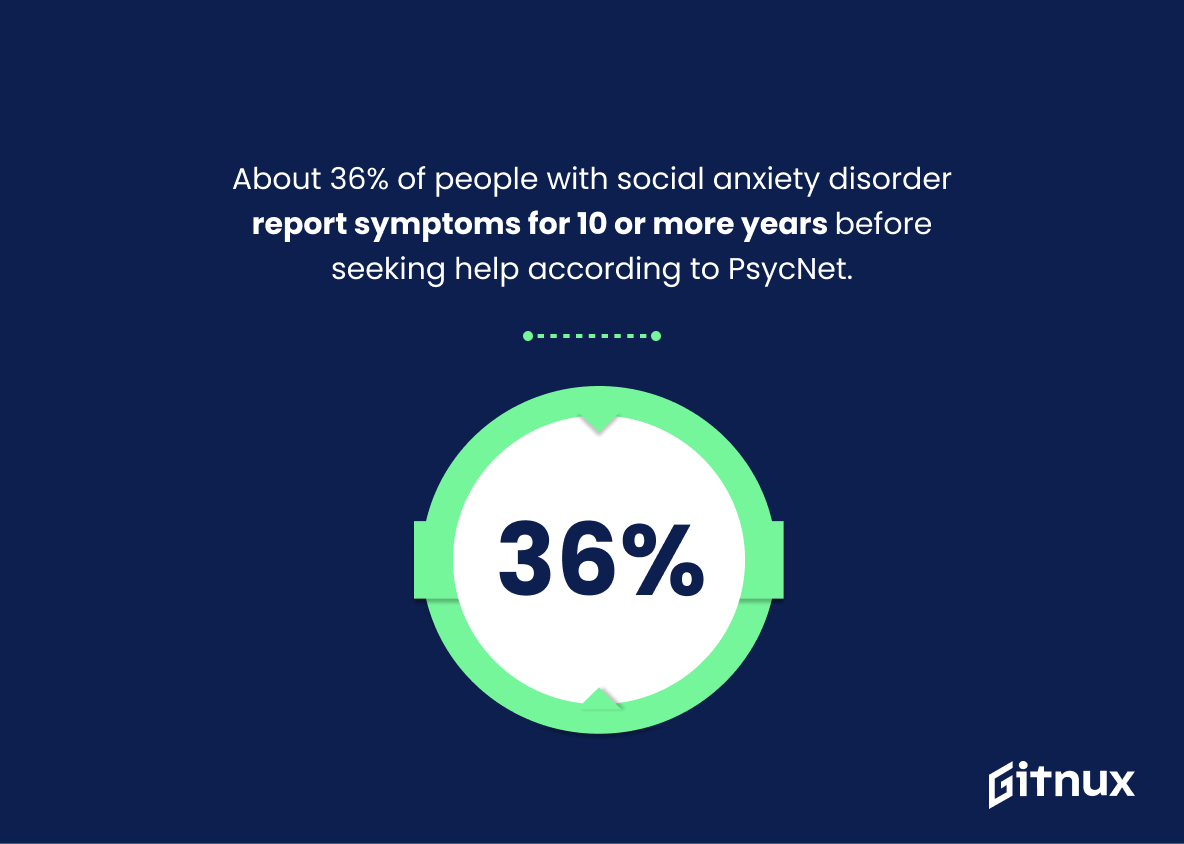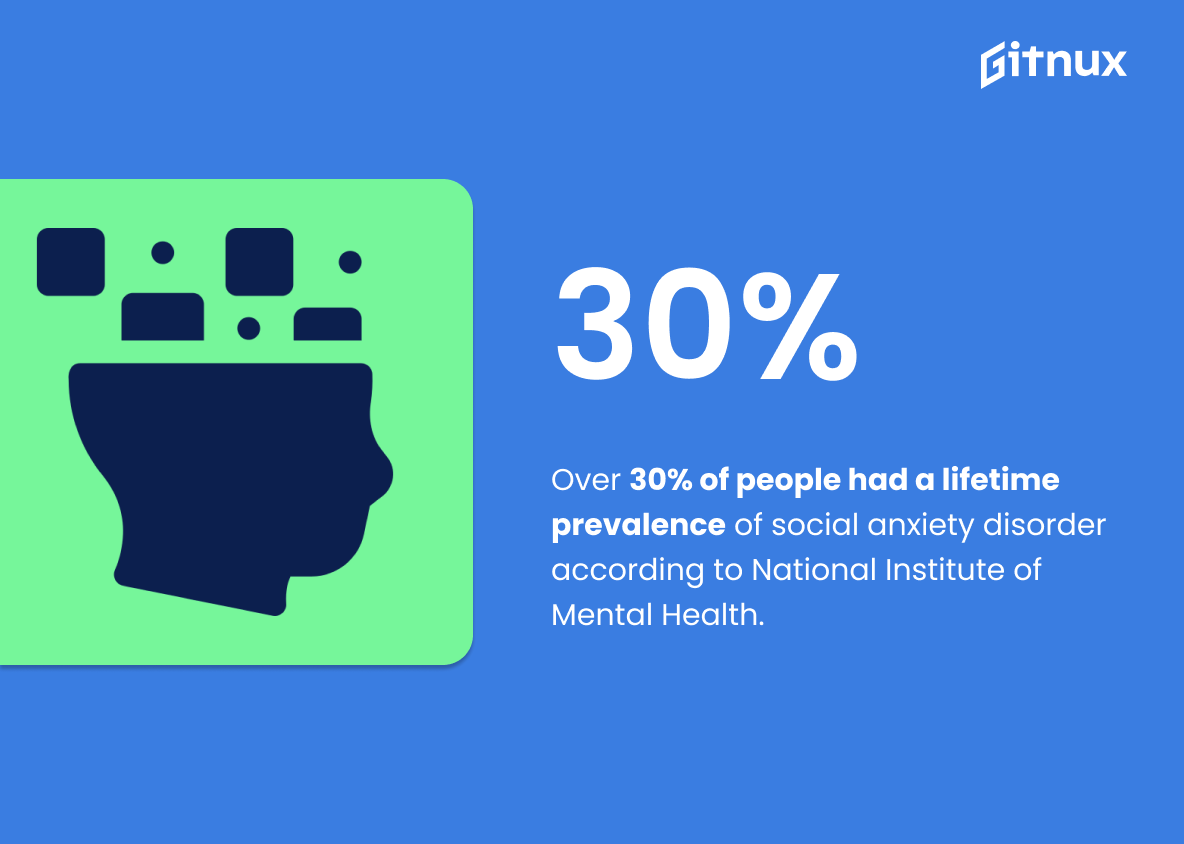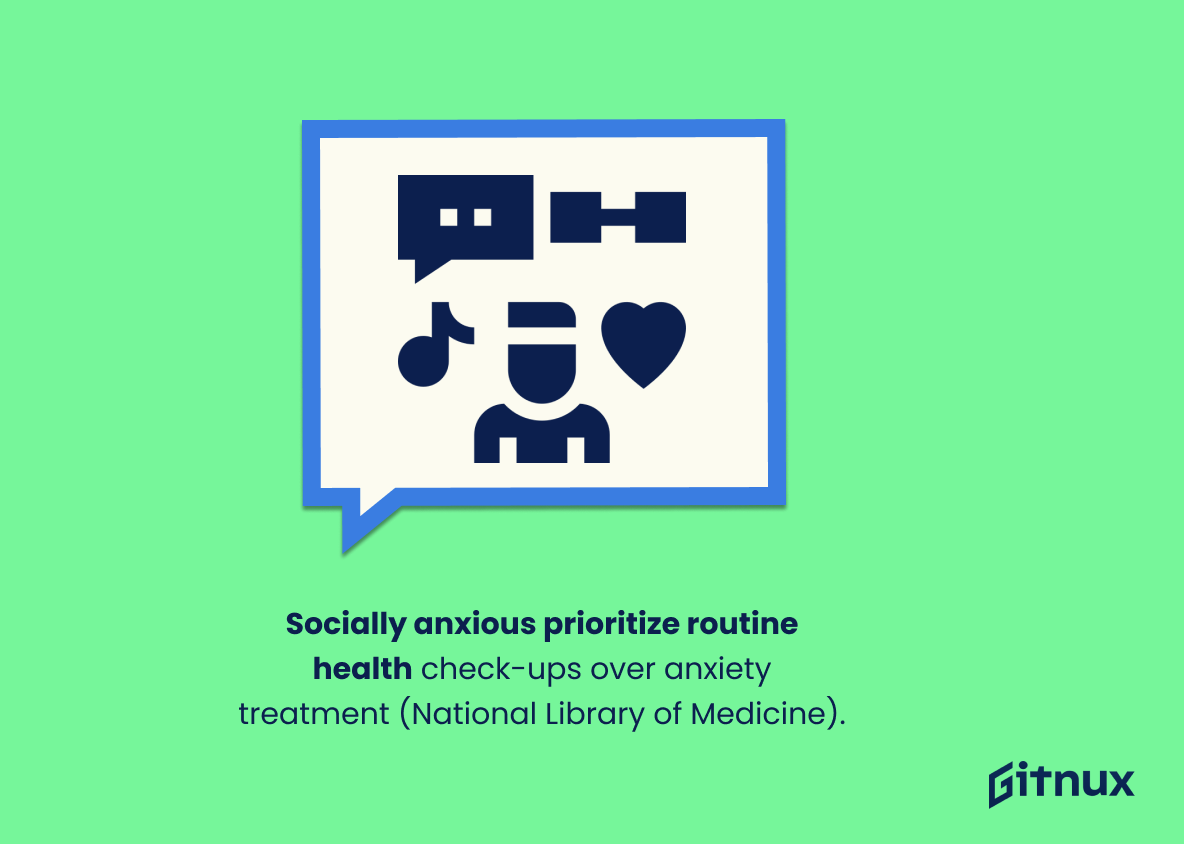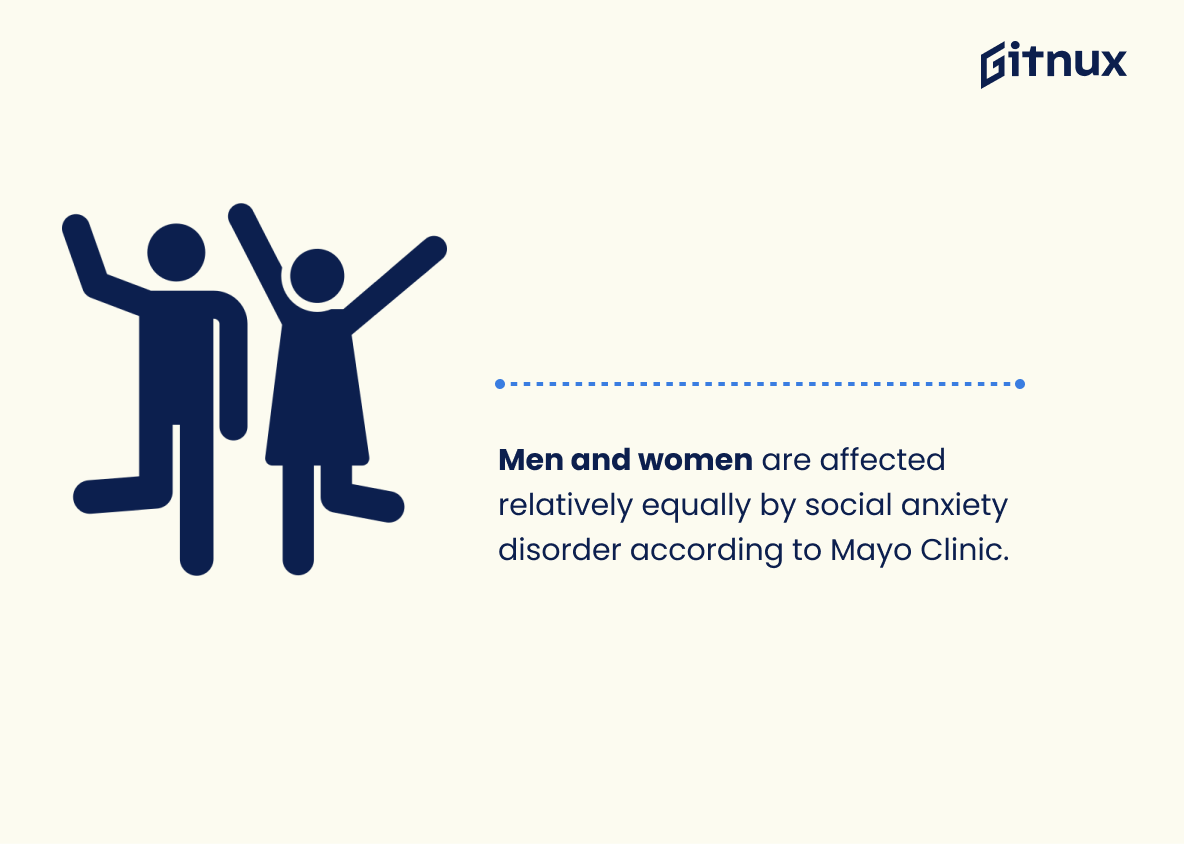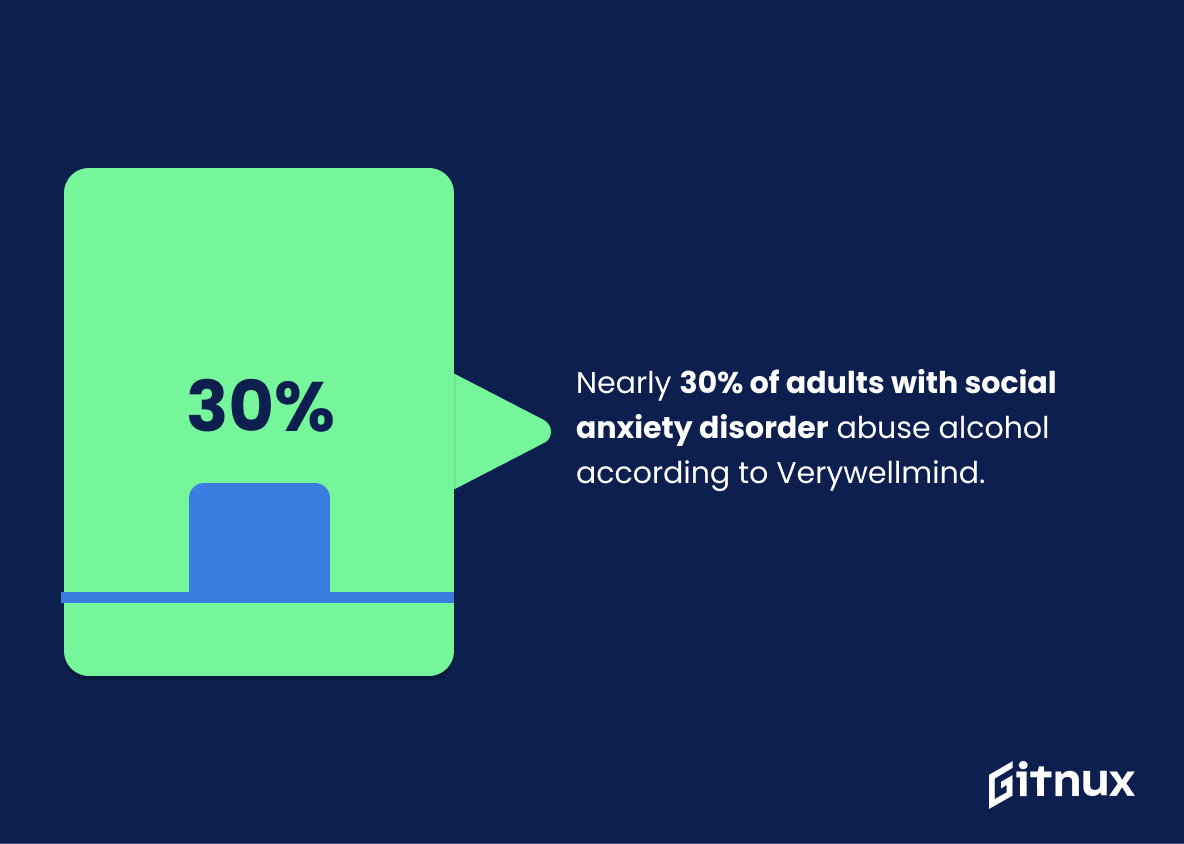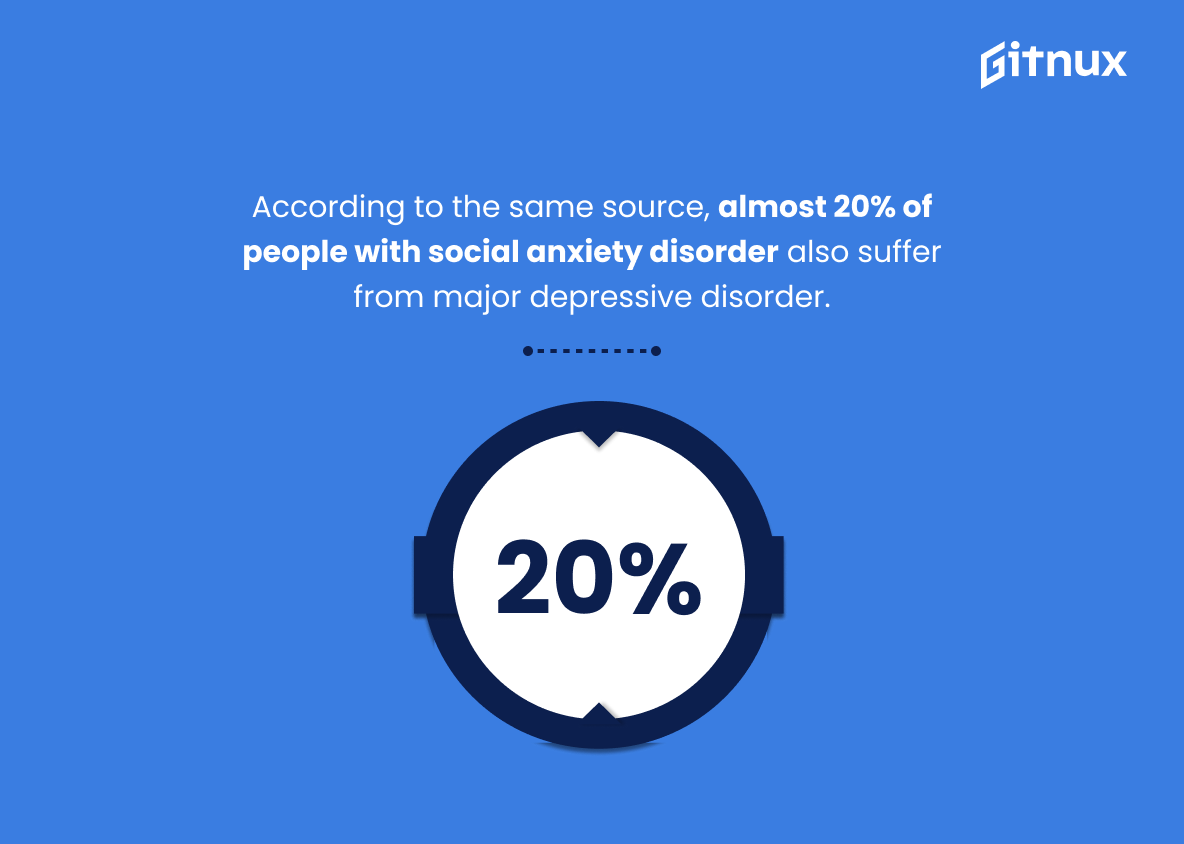Take a moment to consider how often you or someone you know may have felt discomfort or unease in social situations. In today’s ever-connected world, social scenarios are inevitable and can trigger feelings of anxiety for many. But, how many exactly? That’s what we’re here to explore.
Unveiling the surprising world of social anxiety statistics, we delve into the prevalence of this common, yet often misunderstood, mental health condition. We’ll examine the numbers and the real human stories they represent, shedding light on the facts and debunking prevalent myths.
The Latest Social Anxiety Statistics Unveiled
About 15 million people in the USA suffer from social anxiety disorder according to the Anxiety and Depression Association of America.
In the grand mosaic of social anxiety statistics, the tile revealing that about 15 million people in the USA grapple with this disorder, as presented by the Anxiety and Depression Association of America, draws significant attention to the magnitude and prevalence of the issue nationwide. This figure, striking in its enormity, underscores the urgency to delve into a deeper understanding of the disorder, create effective treatments, and implement preventative measures.
With every fifteenth person you might pass on the streets potentially wrestling with this mental health challenge, it amplifies the importance of the blog post in enlightening readers about the scale of social anxiety, its impact on individuals, society, and urging further research and public discourse on mental health.
Around 7% of the population experiences some form of social anxiety disorder in any given year according to WebMD.
Illuminating the magnitude of social anxiety, encapsulated in the striking statistic from WebMD indicating that approximately 7% of the population experiences this form of disorder each year, serves to underscore the pervasive nature of the condition, serving as a clarion call to readers. Not only does it ground the discussion in the personal experiences of millions, it also paints a vivid picture of the silent epidemic ravaging our society every single year.
These percentages convert into real people – neighbors, schoolmates, colleagues – potentially struggling with social interactions on a daily basis. By sharing this statistic in our blog post about Social Anxiety Statistics, we are acknowledging the widespread impact of and advocating for increased attention, understanding, and dialogue around social anxiety. Such recognition can be a cornerstone in developing effective interventions and providing much-needed support for those affected.
The average age of onset for social anxiety disorder is during the teenage years, around 13 years according to ADAA statistics.
Peeling back the layers of this statistic reveals its true importance. By shedding light on the tender age of around 13 as the average onset for social anxiety disorder, the ADAA paints a crucial picture. This information is pivotal in guiding preventive measures, early interventions and resource allocation towards this sensitive age group. Imagine the impact this could hold. Teenage years are marked by significant transformations – physically, mentally, and socially.
By understanding and recognizing how social anxiety typically emerges during this crucial period, readers, parents, educators and healthcare professionals can be more vigilant and effective in providing timely help. Thus, fostering resilience, improving mental health support, and potentially transforming the trajectory for countless young lives.
Only about 50% of people with social anxiety disorder receive treatment for their condition according to Verywellmind.
Shining a light on the telltale statistic, we unmask a startling reality that underscores the depth of the issue addressed in this blog post on Social Anxiety Statistics. Merely half of those grappling with social anxiety disorder ever find themselves under the therapeutic umbrella of treatment, a fact captured poignantly by Verywellmind. This cuts deeper than a mere number, embodying a major setback in our quest to battle social anxiety and its gnawing effects.
Unaddressed, these individuals become echoes of their potential selves, their lives cramped by an unseen, yet very tangible, foe. The statistic also implicitly nudges us towards the envelope of social stigma, lack of awareness, accessibility, and affordability of mental health care, all of which play crucial roles in this melancholic narrative.
About 36% of people with social anxiety disorder report symptoms for 10 or more years before seeking help according to PsycNet.
Undeniably, the drawn-out struggle of dealing with social anxiety disorder symptoms for over a decade before seeking help, as reported by 36% of individuals according to PsycNet, is nothing less than devastating. This grim figure drops a stark spotlight on the necessity to bring awareness to this distressing disorder, revealing how this issue isn’t simply a fleeting problem, but rather a lengthy, silent torment for many.
This statistic seeks to reverberate within the realm of mental health discussions, powerfully advocating for early intervention, increased societal understanding, and comprehensive support systems to aid those silently suffering from social anxiety. It unfolds a poignant narrative, one that emphasizes the courage it takes for these individuals not just to survive, but to take steps towards healing.
Over 30% of people had a lifetime prevalence of social anxiety disorder according to National Institute of Mental Health.
Stepping into the spotlight of this intriguing discussion about Social Anxiety Statistics, the revelation that, according to the National Institute of Mental Health, over 30% of individuals have grappled with social anxiety disorder at some point in their lives, cannot be sidelined. This potent quarter of the population quietly wrestling with unease in social interactions, lends a stark significance to our discourse.
By shedding light on this bountiful yet often concealed segment of society, we unfurl the panorama of social interactions entwined in an invisible, yet often incapacitating, string of anxiety. Being armed with this statistic, we are paving the way for wider discussions, impactful social understanding, and more targeted, effective interventions for those people who seek refuge from the often debilitating walls of social anxiety.
Socially anxious people access treatment more for routine physical health check-ups than for their anxiety issues according to The National Library of Medicine.
Unveiling an intriguing portrait of the health habits of those living with social anxiety, this revelation from The National Library of Medicine emphasizes a paradoxical approach to healthcare. On one hand, it underlines the conscientiousness of individuals with social anxiety about their physical well-being, frequently seeking routine check-ups. Yet at the same time, it portrays a glaring neglect towards their prominent psychological struggle.
The comprehension of this trend becomes pivotal for a comprehensive understanding of social anxiety. In terms of a blog post about Social Anxiety Statistics, it contributes to a richer, more nuanced narrative, shedding light on the potential barriers that deter people from seeking help for their anxiety issues, and highlighting areas where public health communication and behavioural interventions can be improved. Additionally, it highlights the need for integrated care at healthcare facilities, where both physical and mental health can be addressed concurrently.
Men and women are affected relatively equally by social anxiety disorder according to Mayo Clinic.
Highlighting the equal impact of social anxiety disorder on both genders, as reported by Mayo Clinic, underscores the universal reach of this condition, transcending the boundaries of gender. In a blog post dedicated to social anxiety statistics, this revelation dismantles stereotypical views that might associate emotional health conditions with one gender over the other.
Equally impacting men and women, social anxiety disorder emerges as an unbiased force, defying the conventional idea of gender-based differences in emotional response and mental health issues. In essence, this equal susceptibility serves as a reminder that the quest for mental health understanding and solutions should be equally pertinent for both genders.
Nearly 30% of adults with social anxiety disorder abuse alcohol according to Verywellmind.
Interpreting this significant figure, it’s evident that nearly one in three adults struggling with social anxiety disorder also grapples with alcohol abuse. By embedding this statistic into a blog post about Social Anxiety Statistics, we illuminate an intriguing intersection between two pervasive social health issues — social anxiety and alcohol addiction.
This connection allows us to delve deeper into the ripple effects of social anxiety disorder, offering a more comprehensive view of its impact on an individual’s overall life quality. It not only underscores social anxiety’s pervasive impact but also provokes thought on potential ways to preemptively address the dual diagnosis. Hence, readers can reevaluate their understanding of social anxiety disorder, enriching the discussion in a uniquely powerful way.
According to the same source, almost 20% of people with social anxiety disorder also suffer from major depressive disorder.
This statistic directly points towards the intricate link between social anxiety disorder and major depressive disorder, underscoring a crucial aspect to understand in the larger context of social anxiety statistics. The intertwined nature of these two disorders suggests a heavy burden on the emotional well-being of those affected, hinting at the complexity of diagnosis and treatment.
Not merely an isolated issue, social anxiety intersects with other mental health conditions, ultimately amplifying the necessary importance of comprehensive mental health care strategies. This statistic also emphasizes the necessity for broader conversations around co-occurring disorders for a more profound understanding of social anxiety.
59.1% of patients with social phobia met criteria for at least one other psychiatric disorder according to NCBI.
Peering into the depths of social anxiety disorder, a profound revelation from NCBI facts surface as it unearths the compelling overlap between social phobia and other psychiatric disorders. An alarming 59.1% of individuals battling social phobia were not fighting a solitary war, as they met criteria for at least one other enemy in the form of a psychiatric disorder.
This collision of disorders profoundly emphasizes the intricate labyrinth of mental health, serving as an urgent call for a nuanced approach to diagnosis, treatment, and understanding of those navigating life with social anxiety. Such eye-opening statistics further spotlight the urgent need for comprehensive mental health care, emphasizing the necessity to view social anxiety not as an isolated phenomenon, but as a complex tapestry interwoven with other psychiatric conditions, demanding a multidimensional approach for optimal care and recovery.
Social anxiety disorder affects about 5.3 million adult Americans according to National Institute of Mental Health.
Highlighting the sheer volume of adult Americans impacted by social anxiety disorder paints a compelling picture of the nationwide scale of this mental health issue. This concrete figure not only underscores the gravity and prevalence of social anxiety, but also encourages greater societal understanding and empathy. As we explore the deeper layers of social anxiety statistics in this blog post, this stark and sizable figure provides a jumping-off point, signaling a pressing need for comprehensive solutions, research, and mental health resources.
Over 20% of people with social anxiety also have an additional anxiety disorder according to Medical News Today.
Delving into the layered complexity of anxiety disorders, the snippet of information from Medical News Today is fascinatingly crucial in illuminating the issue of social anxiety. It uncovers a compelling reality: over one in five individuals battling social anxiety are also contending with an additional anxiety disorder. This revelation not only heightens our understanding of the intricacy involved with social anxiety but also underscores potential challenges in treatment.
For readers, this statistic might be a revelation or a mirror reflecting their struggles, bridging the gap between personal experiences and broader medical comprehension. It underlines the necessity to address and manage these overlapping layers of disorders for more effective treatment. Plus, it brings into focus the importance of elaborate diagnosis and personalized treatment plans in mental healthcare.
Around 12% of Canadian adults would experience social anxiety disorder in their lifetime according to Canadian Psychology.
Delving into this compelling statistic offers a revealing glimpse into the mental health landscape of Canada – a reality where approximately 1 in 8 adults grapples with social anxiety disorder within their lifetime. It punctuates the ubiquity of this often-overlooked issue, serving as an invaluable reference point to contextualize the enormity of the problem.
Furthermore, this statistic has the power to resonate with those who find themselves in its scope, potentially acting as a transformative beacon of understanding, and even comfort, in knowing they are not alone in their experiences. It forms a cornerstone for catalyzing conversations about mental health, painting a stark picture of the urgent necessity for targeted intervention strategies, robust support frameworks, and proactive preventative measures.
Around 87% of individuals with social anxiety disorder also have another psychiatric disorder at some point in their lives according to StatPearls.
In unweaving the intricate threads of social anxiety disorder, this remarkable statistic from StatPearls offers an intriguing vista. It delineates the profound link and intersection between social anxiety disorder and other psychiatric disorders, manifest in approximately 87% of individuals. This statistic warrants extra vigilance in the evaluation, treatment, and tracking of social anxiety disorder. Its importance is manifold – it underscores the compounding battle many individuals face, as they grapple with not just social anxiety, but other psychiatric conditions.
In the grander scheme of understanding and addressing social anxiety, this statistic places monumental emphasis on comprehensive mental health care and intervention strategies. It’s a clarion call for all clinicians and stakeholders involved to consider the complex, intertwined nature of mental health battles, epitomized by the plight of those with social anxiety disorder. In essence, this statistic is a spotlight illuminating the challenging labyrinth of social anxiety disorder, instructing us to watch for the presence of other mental health tributaries in an individual’s journey.
Conclusion
In summary, social anxiety is a serious and prevalent mental health issue that impacts millions of individuals globally. The statistics clearly reveal the widespread nature of this disorder and the importance of addressing it. As a society, understanding these numbers and the reality they represent can encourage empathy and promote initiatives for preventive measures, therapy, and support.
Bringing awareness to these numbers allows for better intervention strategies, increased prioritization of mental health services, and reduction of the stigma associated with social anxiety. Therefore, while social anxiety statistics paint a daunting picture, they equally illuminate the path towards potential solutions and ultimately, societal change.
References
0. – https://www.www.mayoclinic.org
1. – https://www.www.ncbi.nlm.nih.gov
2. – https://www.adaa.org
3. – https://www.pubmed.ncbi.nlm.nih.gov
4. – https://www.www.verywellmind.com
5. – https://www.www.nimh.nih.gov
6. – https://www.www.webmd.com
7. – https://www.www.medicalnewstoday.com
8. – https://www.psycnet.apa.org
